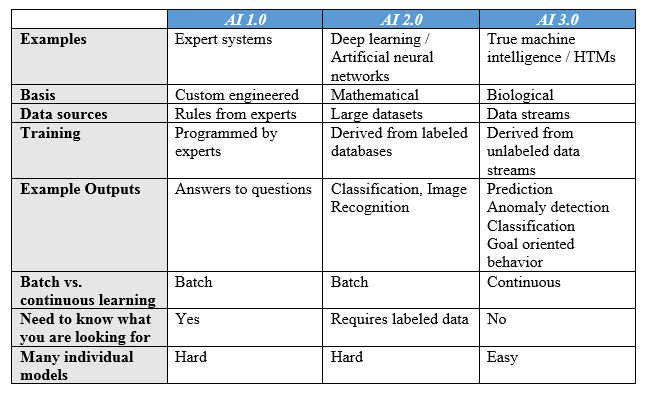Brains have been associated with the field of artificial intelligence for more than half a century. The reason is simple: the brain is the best and perhaps only example we have of an intelligent system. But should the brain serve as mere inspiration or can it be a roadmap, providing the most efficient path to machine intelligence?
More than 50 years ago artificial neural networks, or ANNs for short, were created with the intent of designing something that, like the brain, could learn without expert rules or human supervision. However, ANNs were designed at a time when little was known about how neurons worked in the brain. Neuroscience has progressed greatly since then, but the structure of ANNs has remained mostly the same. This does not render ANNs useless; on the contrary, they perform certain tasks extremely well. They have helped progress the field of machine learning, which relies on mathematical and statistical techniques to analyze large amounts of labeled data, generate statistics and classify results. However, machine learning is not equivalent to machine intelligence.
While ANNs may have been born out of a desire to replicate the process of learning in the brain, this is not how the brain actually learns. We don’t require large amounts of data to learn, and we are consistently exposed to unlabeled data with changing patterns. With what we now know from the field of neuroscience, we should be able to use the brain as more than just inspiration. By reverse engineering the brain, we can understand the core principles of intelligence, and implement them in software and hardware.
How does a biological AI approach work?
At a high level, your neocortex, which is the seat of intelligence in a mammalian brain, learns a model of the world, primarily through behavior. You’re constantly taking in streams of data from your senses, but you don’t learn simply by letting data move relative to you. You also move through the world. Think of how difficult it would be for a baby to learn without crawling, touching and tasting. Behavior, or sensorimotor inference, is an essential part of learning.
There are some additional unique properties of how the brain learns. Numenta’s Hierarchical Temporal Memory was designed to adhere to these biological properties:
- Works on a set of universal, rather than task-specific, algorithms. This means it’s fully automated, with no tuning required.
- Represents information using Sparse Distributed Representation. At any given time in the brain, very few neurons are active, and the ones that are active are distributed across the neocortex.
- Is a memory system that consists of a sequence of patterns and stores what it learns.
- Learning is continuous and unsupervised.
- Demonstrates high capacity and robustness to noise.
- Works well on streaming data sources.
AI 3.0 – what lies ahead?
The AI landscape has given rise to many different approaches to creating intelligent machines, yet most have seen limited success. The next wave of AI, built within the constraints of neocortical theory, is poised to bring about true machine intelligence.

There are already several applications of machine intelligence technology based on neocortical principles. Numenta has applied HTM to anomaly detection, prediction and classification using streaming data. From preventative maintenance to monitoring IoT sensors to identifying unusual traffic patterns – these are just some of today’s practical applications.
The killer app has yet to be determined. But could anyone have predicted Uber at the forefront of the mobile computing era? While it remains to be seen how machine intelligence technology will be used in the world, there’s no question it has the real potential to change it. I, for one, can’t wait.
 Contributed by: Christy Maver, Director of Marketing at Numenta. Christy is responsible for helping to shape the company’s story and communicate it to the world. Christy has nearly two decades of experience with marketing technology, most of which has been spent in the data and analytics space. Prior to Numenta, Christy spent 13 years at IBM in a multitude of roles, and was one of the founding members of IBM’s thought leadership group: the IBM Institute for Business Value. Christy holds a BA in Economics from Princeton University.
Contributed by: Christy Maver, Director of Marketing at Numenta. Christy is responsible for helping to shape the company’s story and communicate it to the world. Christy has nearly two decades of experience with marketing technology, most of which has been spent in the data and analytics space. Prior to Numenta, Christy spent 13 years at IBM in a multitude of roles, and was one of the founding members of IBM’s thought leadership group: the IBM Institute for Business Value. Christy holds a BA in Economics from Princeton University.
Sign up for the free insideBIGDATA newsletter.




The problem with Numenta’s implementation, no one in the main stream can understand or practically use the mathematical basis. Jeff Hawkins did a wonderful job writing a high level book, is a great public speaker and did a great job in some articles illustrating the idea eg ACD, BCE rows with “C” column. Don’t emphasize streams, it works in all context. There is no useful details for the everyday person to use and eventually see the greatness behind it.
They may make substantial progress shortly. There are some indications now that the brain does 3 things. Cues from the environment go for randomly organised walk around parts of the brain. Neurons (ie micro-correlators/recognisers) learn associations of those cues. You end up with billions of those associations. A read out layer picks out those associations that are useful for driving behavior, such as getting a reward. It seems to me that such a scheme would be effective with billions of neurons and trillions of synapses. The engineering fits very well together.
Great read, Brain Theory is definitely a game changer for the Machine Learning